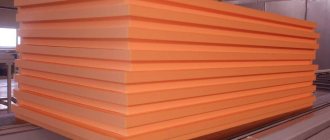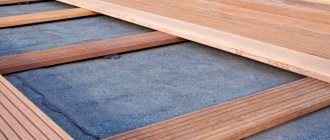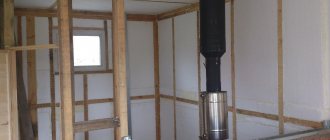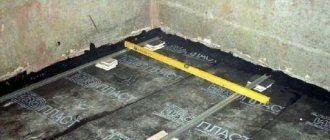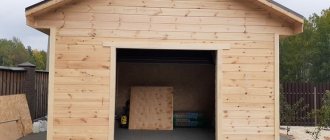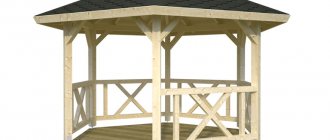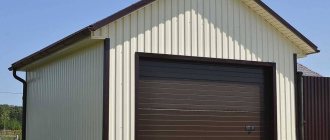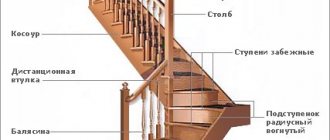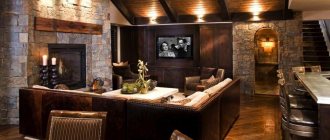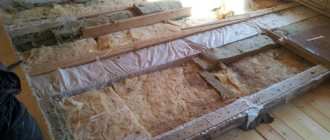The pleasure of living in a wooden house can be overshadowed by the cold penetrating from below, through the cracks of the floor covering. You can eliminate troubles from hypothermia in the lower layers of the room with well-thought-out and carefully executed thermal insulation.
There is a great temptation to insulate a wooden floor with polystyrene foam; You can choose other materials with low thermal conductivity; fortunately, the range allows you to consider a large number of products with different properties and prices.
Why polystyrene foam?
The unique properties of polystyrene foam can significantly reduce heat loss when installed correctly.
This insulation has the best thermal conductivity: regular foam 0.036-0.050 W/mS and extruded 0.028-0.034 W/mS.
The photo shows a comparison of regular and extruded foam
Insulating floors with polystyrene foam not only creates a reliable protective barrier from the cold, but also increases waterproofing
This material has low water absorption, which is very important for insulation. Wet material will simply not be able to provide reliable thermal insulation. EPS has a high density and can withstand high loads of up to 400 kg per square meter
There are also special types that are used for insulating roads and runways - they can withstand even greater loads. Therefore, you don’t have to worry that the floor will shrink after pouring the screed. This material is optimally suited for use with electric and water underfloor heating systems. The material tolerates changes in temperature and humidity well and is not exposed to microorganisms. The plates are light in weight because they consist of closed air capsules. They are easy to cut, fix, and transport. Because of this, the DIY installation process becomes even simpler. Low price - on average, about 4 thousand rubles per cubic meter.
Types of polystyrene foam
Insulation of the first floor of the house
Insulation can be produced by several types of polystyrene foam, which differ in their production method and characteristics.
- Regular foam. It consists of 98% air in a vapor-tight shell. Thanks to this, it has good thermal insulation properties and is light in weight. However, this material is very short-lived, fragile and highly absorbs moisture, so if you use it for flooring, you need to take this into account.
- Extruded polystyrene foam is produced in a completely different way, so it does not have the disadvantages of polystyrene foam. The material is durable, strong in compression and almost does not absorb moisture. However, it also costs more than polystyrene foam.
- Granular foamed polystyrene. Used primarily to add to concrete to increase its thermal insulation.
- Penoizol is a universal insulation material that is applied by spraying it onto the surface. Supplied in liquid form. Unlike ordinary polystyrene foam, it is not capable of spontaneous combustion. Mechanically it is less strong, but more durable.
The most popular brands in Russia are EPPS Penoplex, URSA, TechnoNIKOL. The standard size of the slabs is 60*120 cm and 50*100 cm. Regular foam plastic for living rooms should be chosen with the PSB-S-35 marking, and its quality must meet the requirements of GOST 15588-86.
Fire safety. Modified and unmodified polystyrene foam
Untreated material is very easily ignited by a lit match or sparks from a welding machine. However, it cannot catch fire from a cigarette or a hot metal object.
Modified polystyrene foam (self-extinguishing)
Expanded polystyrene can ignite at temperatures from 200°C to 450°C, in this case it all depends on the additives used in production.
Note! The ignition temperature must be indicated in the certificate that comes with the stoves.
If ordinary unmodified polystyrene foam burns, the temperature around it can exceed 1200°C (albeit not for long). When burned, toxic substances such as hydrogen cyano- and bromide and phosgene are released. If special additives were used, the combustion temperature is reduced to that which is standardized for each specific grade of material.
In the manufacture of modified polystyrene foam, flame retardants (substances that prevent fire) are used. In this case, the material is already considered self-extinguishing and is designated by the letter “C” at the end of the abbreviation (for example, PSB-S).
There is another way to reduce flammability - when the granules expand, the flammable inert gas is replaced by non-flammable carbon dioxide.
Popular types of polystyrene foam
Polystyrene foam is usually produced in the form of slabs. The following types of polystyrene foam boards are most popular among consumers:
In the production of expanded polystyrene, various technologies are used that determine its characteristics, areas of application and installation methods.
Pressless expanded polystyrene
The manufacturing process of this type of material is that polystyrene granules are placed in hot water, and after swelling they are dried and foamed, placed in special molds or an extruder.
Considering the low cost of production, such foam plastic has a very affordable price, and therefore is especially popular among citizens who are puzzled by the installation of a warm water floor.
Extruded polystyrene foam
The foam of this type is produced by mixing polystyrene granules with a foaming agent under pressure and at a high degree of heat. The result is a viscous mass, which is extruded using a special tool equipped with an extrusion head.
Laying extruded polystyrene foam
Extruded polystyrene foam for heated floors is especially popular among installers installing water-based systems. Plates made from this material are also widely used in other areas of construction, for example, for insulating roofs, foundations and facades of houses.
Foiled polystyrene foam
This type of foam has a distinctive feature, which is the presence of an additional metallized layer. This material is often used in underfloor heating systems, as the foil layer acts as a reflector, increasing heating efficiency by evenly distributing heat.
When installing a warm water floor, it is always necessary to lay an additional layer of foil under the pipeline, acting as a reflector. The use of foil polystyrene foam eliminates this need.
However, when laying it, it is necessary to take into account that the concrete screed in which the system is placed completely corrodes the thin layer of aluminum that covers the slabs in a short period of time. Therefore, this material must be protected with an additional layer of waterproofing.
It should be noted that foil polymer insulation can be used when installing water and cable heated floors. But it cannot be used when laying infrared mats.
Profile polystyrene foam
The use of this material makes it easier to install a heated floor system, as it eliminates the need to lay a reinforcing mesh to which the pipeline is attached, apply markings and install guides, since all these functions are performed by bosses located over the entire surface of the slab.
The distinctive features of such a plate are the following factors:
- the bosses themselves, which make it possible to easily lay a water pipeline or an electric heated floor cable, regardless of the chosen scheme;
- increased mechanical strength provided by the high density of the material;
- the presence of a shell that acts as a vapor barrier that protects against moisture;
- a layer of laminated foil, impervious to chemical attack;
- the presence of locking connections, thanks to which the slabs are laid without gaps;
- the presence of a relief pattern on the underside of the slab, which provides ventilation and smoothes out minor irregularities in the base.
Stages of work
The horizontal surface under the floor must be thoroughly cleaned and leveled. If you decide to insulate the floors in an already inhabited house, then before carrying out the work it is necessary to dismantle the floor covering. If it is still in good condition, then remove it carefully so that after work you can put it back in place. Well, if you plan to replace the coating, then you don’t have to stand on ceremony and remove it quickly. Check the condition of the subfloor. If it is deformed or there are defects, carry out work to strengthen it.
Prepared wooden logs must be positioned and secured in such a way that there is a space of no more than 70 cm between them.
The boards on which the penoplex will be laid must be hemmed to the joists or secured to bars specially designed for this.
Before laying the insulation, it is necessary to treat the logs and all wooden elements with antiseptic solutions. This precautionary measure will protect the tree from rotting and damage by bugs. After antiseptic treatment, it would also be useful to treat with a moisture-repellent agent.
First you need to lay out a layer of thick waterproofing film on the boards or plywood , so carry out the work of installing the waterproofing. Keep in mind that this material is overlapped (about 15 cm) to ensure complete tightness and high-quality protection from moisture.
It is possible that it will be useful for you to study the material about insulation for the walls of a house outside under siding.
Floor insulation scheme.
The next step is the direct installation of insulation on wooden boards. When laying out the penoplex, carefully ensure that no gaps or cracks form during the work. Careful placement of the material will provide reliable protection from the cold.
For additional protection from moisture, you can stretch polyethylene film over the surface of the insulation. This technique is of particular importance if the house is located in a swampy area and the climate is rainy.
The floor covering is laid on top: laminate, parquet, solid wood, etc.
By the way, similar work can be done in an ordinary apartment. Such insulation is of particular relevance if you live in an apartment building on the ground floor.
Penoplex can also be used as an insulator under a “warm floor” system. In this case, it will provide additional protection of the room from blowing and heat loss. In order to lay the material in this case, a concrete screed with floor pipes built into it is used.
You will probably want to find out more information about whether it is possible to insulate the ceiling and floor with sawdust.
Insulation of wooden floors
Wooden floors are quite common both in apartments and in private sector houses. They are environmentally friendly, easy to install and have good strength characteristics. However, on the lower floors, the relatively low thermal conductivity of wood is simply not enough to provide the proper level of heat, which means that the floors still need to be insulated. And here foam plastic would be an excellent option.
As far as we know, a wooden floor is an entire structure that requires the presence of an air gap between the plank covering and the ceiling. And it is precisely in this space that foam blocks need to be laid. Even a novice builder or a person who is far from construction, but decided to repair or simply insulate the foundation himself, can do this work.
Insulating a wooden floor with foam plastic
In any case, the use of polystyrene foam requires careful preparation of the base. That is, it must be cleaned, leveled, and all cracks must be sealed. After this, a waterproofing coating is laid, on which the foam is then laid. But first, logs made of wooden beams are installed.
Floor insulation technology on joists
Foam blocks must be laid tightly, without gaps, and the joints between them can be foamed to reduce the number of cold bridges. Next, it is recommended to cover the foam with another layer of waterproofing.
Technological difference between internal and external wall decoration
Most often, interior wall finishing is done using wet technology, that is, using glue. To save space inside the house, you should not use an additional frame or anything else. The stages of work are as follows:
- Surface preparation and adhesive application.
- Installation of foam plastic boards and blowing out the joints between them.
- Applying the base layer of plaster.
- Applying the final layer of plaster.
Exterior finishing is also done using wet technology in most cases. There is almost no difference between them. External installation differs only in some details and the number of work processes. An insulating film is used here, since external factors act on the foam from the outside. Stages of work:
- Cleaning the base and priming it.
- Installation of the base profile.
- Layout of insulation placement and “fitting” on glue.
- Eliminate gaps with foam and fix them with dowels.
- Attaching the waterproofing film.
- Applying the first layer of plaster.
- Reapplying a layer of plaster.
- Final application of the third layer of plaster.
- Decorative finishing upon request.
Insulation of the concrete base
Concrete floors are distinguished by high reliability indicators; they are usually very smooth and durable; they are not afraid of serious loads. However, it cools down quickly, does not retain heat, and the cold lets in easily. That is why concrete floors must be insulated. And here, too, polystyrene foam comes to the rescue. However, depending on whether there is a basement under the concrete floor or not, the insulation technology will also differ.
Floor screed with foam plastic
If there is a basement
This section is relevant for owners of private houses or those who have apartments on the ground floors. Concrete floors in these cases are quite cold, and even a good floor covering will not save you from discomfort. Here it is recommended to mount the insulation on the basement side, then the concrete slab itself, that is, the ceiling, will be in a layer of air and will better retain heat, and the cold will not penetrate into the house.
It is best to use foam plastic with a thickness of 5-10 cm, as is the case with wooden floors
If the concrete slab is uneven, then in any case it is important to prepare it for the installation of foam sheets. All cracks on it, if any, are sealed with polyurethane foam.
Insulation of the floor above the basement without heating
You can fix the foam on the concrete using dowels 12-14 cm long. You need to work slowly, drilling holes in the concrete with a hammer drill, marking places for fastenings. Before fixing the material, apply a special adhesive suitable for foam plastic to the surface of the concrete. The joints between fixed sheets can be covered with polyurethane foam.
Cellar insulation with foam plastic
No basement
If there is no basement in the house, and the apartment is located above the first floor, then another technology for floor insulation with foam plastic is used. In this case, the sheets are installed above a concrete surface. The old floor covering is completely removed, all cracks in the base are sealed, and the floor is leveled. It is best to seal cracks with thick cement mortar. Only after this is the floor waterproofed with special compounds or materials. The easiest way is to use bitumen mastic, but in some cases roll material will also be convenient.
The use of polystyrene foam for floor insulation
Afterwards, a reinforcing mesh or ordinary masonry is laid on the surface of the waterproofing. And only then sheets of foam plastic are placed on it. But here you can use thin sheets about 2-3 cm thick. The main thing is to install it with a minimum of joints so that cold bridges do not form. It is best to fix the foam with special glue.
Next, after laying the foam, the beacons are installed using a laser level. They can be fixed with the same mounting adhesive. Beacons are placed at a distance of no more than 1.4 m from each other, but at the same level. After this, a screed solution is poured over the foam - a regular concrete screed is performed, and the foam will be sealed on both sides with concrete surfaces.
Beacons for foam screeds
How to insulate insulation
Environmental influences, moisture, temperature changes, cold have a certain effect on any materials. Areas where access is restricted require special attention. To protect wooden walls and house structures when insulating with polystyrene foam, it is necessary to pay attention to waterproofing and vapor barrier. For this purpose, special roll materials are used.
Vapor barrier film
During the insulation process, the waterproofing material must be fastened on the cold air side (street, ground, concrete base). The vapor barrier is installed on the side of the warm air flow (inside the room). An alternative vapor barrier option can be polyethylene film used to cover garden greenhouses.
Techniques for performing insulation work for floors
There are two main options for thermal insulation:
- Thermal insulation on joists. When choosing this technology, the insulation in the form of slabs has to be laid out in a checkerboard pattern. Stitches also need to be re-dressed. You should first lay a special film to ensure waterproofing. The material can be fixed using either dowels or glue. Having completed the installation of the slabs, the seams are carefully sealed using polyurethane foam, and then the floor covering is attached to the joists. If you choose reliable insulation, such a floor will retain heat.
- Insulation completed with screed. If you are thinking about how to properly insulate the floor in a wooden house, consider the thermal insulation option, which involves creating a concrete screed on top of the thermal insulation layer. First of all, waterproof the base. The next step is laying a mesh made of fiberglass. As a result, the structure becomes stronger. Next, concrete mortar is applied over the mesh.
Methods
There are two fundamentally different options for carrying out floor insulation work.
In some cases, flooring is made of heat-insulating materials over beams. The result is a cake consisting of two plank floors, between which a waterproofing film is laid out, and a layer of insulation on top. In such structures, the wood, despite preventive measures, gradually becomes saturated with moisture and begins to rot.
Another type of insulation is performed directly on the ground by casting a reinforced concrete monolith with a lower waterproofing gasket and an upper heat-insulating layer. The resulting slab, in fact, is a cushion floating on the foundation, withstands and transfers to the ground the load from the weight of the inhabitants, furniture and household appliances in the house.
The insulation in such structures must have high densities and low hygroscopicity, because some moisture can seep through the waterproofing and concrete.
Advantages of using foam plastic in thermal insulation of floors
The color of the material does not in any way affect the quality characteristics and features of working with insulation.
The key advantages of using foam boards for thermal insulation include:
- The insulator has excellent ability to retain heat indoors;
- Subject to certain operating conditions, PPS is absolutely safe from an environmental point of view;
- Polyfoam also has excellent hydro and sound insulating properties;
- PPS can also be praised for its durability in operation.
Foam plastic is resistant to negative external factors. That is why the material is considered one of the best types of thermal insulators.
Details about the properties of the material can be studied in the video:
Disadvantages of polystyrene foam
Polystyrene foam is far from an ideal material; it also has its own disadvantages, which you need to know about in order to draw your own conclusion whether or not to buy such material for floor insulation. The main ones are the following.
- Low strength indicators. The material is easy to damage or break. But at the same time it is easy to cut.
- The material is afraid of the effects of varnish or paint - it is destroyed because of them.
- This is not a breathable coating, although it is full of air in itself.
- If there are mice or rats in the house, they can greatly damage this type of insulation. Therefore, it is best to cover foam blocks with plaster.
- This is not an environmentally friendly material, and if it is set on fire, it releases a huge amount of toxic fumes into the air. But the foam itself is absolutely safe for humans.
- You still need to create a frame for foam plastic, but in the case of this material it can not be made as powerful as when using the same mineral wool.
The use of polystyrene foam for floor insulation has its disadvantages
Why is it better to insulate with foam plastic?
There are a number of factors:
- Materials from the expanded polystyrene group are ideal for arranging floors, as they help solve two problems simultaneously: they provide thermal insulation and prevent the penetration of steam and moisture. Owners of residential and commercial premises located on the first floors are especially in dire need of vapor and waterproofing.
- Polystyrene foam and its extruded “brother” do not absorb ground moisture, which, being an ideal conductor, significantly reduces the insulating properties.
- A square meter of materials can hold a load of up to 350-400 kg without destroying the structure, which significantly exceeds the performance of most finishing floor coverings.
- This type of insulation is compatible with electrical and water equipment of “warm floor” systems.
- The structure and geometric parameters of materials do not change either from moisture, which causes swelling of most insulation materials, or from prolonged exposure to high temperature.
- Expanded polystyrene is resistant to negative factors of chemical and biological origin.
- Simple, non-labor-intensive installation. The slabs can be easily cut to create small segments; using polystyrene foam, you can insulate floors in rooms of any size or configuration.
And the main advantage is the affordable price, affordable for most who want to make repairs or build their own home and carry out effective floor insulation with foam plastic at budget rates.
Floor insulation with foam plastic - cheap, effective
Its pros and cons
Pros of polystyrene foam:
- Easy to process and does not require expensive special tools.
- Light weight, allowing the material to be attached to any surface.
- High thermal insulation properties.
Disadvantages of polystyrene foam:
- They ignite easily, releasing toxic substances, and fire-resistant foams cost half as much.
- They do not allow water and steam to pass through, so insulated surfaces must be protected from steam and water
- Mice live in the insulation.
Features of floor insulation in the loggia
Glue method
The loggia space is usually not large, so extruded polystyrene foam can be laid without a frame base. The fixation method is called adhesive.
A special adhesive composition for foam plastic is purchased. It is diluted according to the instructions.
The smooth surface of polystyrene foam is rolled with a toothed roller. This will provide better adhesion to the glue and the subfloor of the loggia.
The adhesive is applied with a notched trowel onto a clean, prepared floor surface or onto foam sheets.
Then the EPS and topcoat are laid.
This method of insulation goes well with the installation of heated floors and/or pouring a thin concrete screed.
Floating or frame method
To secure the logs to the concrete slab of the loggia, holes are made in it with a hammer drill, dowels are inserted, and the logs are pressed against them with self-tapping screws.
The surface, together with the bars, is covered with a layer of waterproofing (it is fixed to the wood using a stapler).
Expanded polystyrene slabs are placed in the grooves between the frame, then another layer of film (or foil insulation) and the finishing floor. A small air gap of 2–4 cm is left between the surface of the film and the finished floor.
Balcony slabs are made with a slope towards the street and a gap for rainwater drainage. But if glazing is carried out and the balcony is converted into an additional room, the need for a slope and cracks disappears. Therefore, at the stage of constructing the frame, it is possible to level the floor.
Frameless and frame methods of insulation
There are several methods of insulation - frameless and frame. What is their difference? The first one differs in that when insulating, the foam is mounted close to the wall.
All surfaces are treated in a certain sequence so that the insulation adheres better. The frame method of insulation differs in that processing is required only where the guide bars will be installed.
Insulation of wooden floors
Wooden floors are quite common both in apartments and in private sector houses. They are environmentally friendly, easy to install and have good strength characteristics. However, on the lower floors, the relatively low thermal conductivity of wood is simply not enough to provide the proper level of heat, which means that the floors still need to be insulated. And here foam plastic would be an excellent option.
As far as we know, a wooden floor is an entire structure that requires the presence of an air gap between the plank covering and the ceiling. And it is precisely in this space that foam blocks need to be laid. Even a novice builder or a person who is far from construction, but decided to repair or simply insulate the foundation himself, can do this work.
Insulating a wooden floor with foam plastic
In any case, the use of polystyrene foam requires careful preparation of the base. That is, it must be cleaned, leveled, and all cracks must be sealed. After this, a waterproofing coating is laid, on which the foam is then laid. But first, logs made of wooden beams are installed.
Floor insulation technology on joists
Foam blocks must be laid tightly, without gaps, and the joints between them can be foamed to reduce the number of cold bridges. Next, it is recommended to cover the foam with another layer of waterproofing.
Surface preparation
An important step before starting to insulate a wooden house is preparing the foundation. The reason for this is wood, which is very capricious to many factors. Old houses and new buildings are insulated. It is necessary that the surface is dry, the wood must be dried. If the house has been painted, then all paint must be removed. The joints between logs or beams must be well caulked. If additional caulking is necessary, this must be done before insulation. You should also fill up all potholes and remove any remaining bark if present.
As soon as the surface is ready, it is treated with antiseptic agents. The choice of composition is a responsible step, because in the future the contact between polystyrene foam and wood will not be visible. It is necessary to create such conditions so that the walls of a wooden house do not end up in conditions that expose them to rot and further destruction. It is recommended to read the instructions for use before purchasing.
How to insulate a floor yourself
Experts love it for its unpretentiousness, resistance to various chemicals and water, and ease of installation. Anyone can install thermal insulation; it is enough to have a cutting knife and polyurethane foam for sealing on hand. In this case, no protective equipment is required, as when working with mineral wool, the material does not crumble like polystyrene foam, and does not emit toxic fumes like polyurethane foam. However, there are some preparatory features that the master should know before starting work.
A clever meter that saves electricity. Pays for itself in 2 months! Everyone needs to know this in order to save!
Insulation of the floor in a wooden house should begin with preparation of the base and careful vapor barrier. If there is no basement or ceiling, then it is better to compact the earth, create a cushion up to 10 cm thick using crushed stone, then a filling layer of fine sand. The foundation prepared in this way will withstand all loads.
Thermal insulation of the floor with extruded polystyrene foam is carried out as follows:
- An uneven base is leveled using bedding or quick-drying putty.
- A vapor barrier film is laid with an overlap of at least 10 cm. The joints are secured with adhesive tape.
- A frame made of timber with a cross-section of 5x3 or 5x5 cm is mounted. Insulation, cut to size, is inserted into the “windows”, the gaps are filled with polyurethane foam or styrofoam putty.
- The top of the lathing is covered with glassine and a subfloor (chipboard, plywood or gypsum fiber board) is laid, then the decorative finishing coating is laid. Instead of a rough base, you can immediately install a finished floor from a board.
The cost of insulating such a floor will be:
- leveling mixtures - from 150 rubles per package.
- vapor barrier – from 15 rub/m2;
- timber - from 40 rubles/linear. m;
- polystyrene foam boards - from 130 rub/m2;
- glassine or construction plastic – from 35 rubles/m2;
- plywood, chipboard - from 180 rub/m2.
Insulation of a concrete floor with polystyrene foam
Do-it-yourself thermal insulation under the screed is carried out in 2 ways.
The first method is to insulate the base without lathing:
- Preparing the floor. If the soil acts as this, then it must be compacted well, pour a layer of crushed stone 10-15 cm thick, and level it with sand (fine fraction). If this is a floor slab from a basement, then laying a vapor barrier film with an overlap of up to 15 cm is required.
- Laying slabs end to end. The gaps are filled with polyurethane foam, and an expansion joint is left around the perimeter for thermal expansion of up to 1 cm.
- Waterproofing flooring with an overlap of 10-15 cm. The joints are secured with adhesive tape.
- Reinforcement. A mesh is laid, the purpose of which is to strengthen the structure and ensure uniform distribution of loads.
- Concrete floor screed in a layer of 5-10 cm.
The floor screed with polystyrene foam for the finishing coating is ready. Costs for its installation include:
- means for filling and leveling - from 30 rubles/kg;
- steam and hydrobarrier – from 15 rub/m2;
- expanded polystyrene boards - from 130 rub/m2;
- reinforcing mesh – from 60 rub/m2;
- self-leveling floors (ready-made dry construction mixtures) – from 300 rubles/bag.
The second method is on a frame made of logs. The technology is the same as for wooden flooring, only instead of a subfloor, a screed from ready-made mixtures is poured.
Installation of sheathing
To install insulation, you need a frame that securely holds the material, does not allow it to slide down over time, and allows the material to be ventilated. It is necessary to use only dried wood, otherwise the bars may twist after installation. Expanded polystyrene suffers from this, gaps form (cold bridges), and the finishing and façade material may also be damaged. Before installation, it is recommended to treat the bars with an antifungal and antiseptic agent.
The bars are attached to wooden walls with self-tapping screws vertically and horizontally. To do this, the bars are sawn through at the junction points and a groove is made for the connection.
Connecting bars into half a tree
The distance between the bars should be approximately 5 mm less than the width of the insulation. This will allow the polystyrene foam to fit tightly into place, eliminating any gaps. If several layers are to be laid, the seams of the subsequent layer should overlap the seams of the previous one.
It is easy to insulate wooden houses made of timber, but log houses are more difficult. The surface is not flat, so special attention must be paid to its preparation. You can use spray foam or seam sealant to repair potholes and small uneven areas.
General information
Extruded polystyrene foam is a thermal insulating synthetic material created in the fifties of the last century in the USA by specialists from The Dow Chemical Company. It was then that a more modern technique of foaming a special “cocktail” of polymers during extrusion (extrusion through a die) was first used.
At first, the foaming reagents were carbon dioxide and freon. But since 1999, due to the fact that freon has a detrimental effect on the ozone layer of the planet, they began to use a freon-free method for manufacturing the material.
Extruded polystyrene foam
Technical characteristics and types of extruded polystyrene foam
| Index | Polyspen | Polyspen Standard | Polyspen 45 | Control method |
| Density, kg/m3 | 30-38 | 30-38 | 38,1-45 | 5.6 each |
| Bending strength, MPa, not less | 0,4 | 0,4 | 0,4 | 5.8 each |
| Water absorption in 24 hours, % by volume, no more | 0,4 | 0,4 | 0,4 | 5.9 each |
| Thermal conductivity at 25+-5 degrees Celsius, W/m * °C, no more | 0,028 | 0,028 | 0,030 | at 5.10 |
| Toxicity, Hcl 50, g/m3 | T2 moderately hazardous | T2 moderately hazardous | T2 moderately hazardous | at 5.11 |
| Flammability group | G-3 normal-flammable | G-4 highly flammable | G-4 highly flammable | at 5.12 |
| Flammability group | B-2 moderately flammable | B-3 flammable | B-3 flammable | at 5.13 |
| Smoke coefficient | High smoke generating ability | High smoke generating ability | High smoke generating ability | at 5.14 |
| Compressive strength at 10% linear deformation, MPa, not less | 0,2 | 0,2 | 0,3 | 5.7 each |
Recommendations for selecting polystyrene foam
Thickness is the main and most important criterion when choosing polystyrene foam, and here you cannot be guided by the rule that the thicker the insulation, the longer it will last. After all, if the material is thick, there is a possibility that the material inside will begin to bulge when the temperature changes.
Indeed, it is important to take into account the density of the material, as well as manufacturing standards (when purchasing, look carefully at the fault line, it must be correct), it is worth choosing well-known manufacturers.
Features of floor insulation with polystyrene foam
Extruded polystyrene foam is a granular thermal insulator made from polystyrene and styrene copolymers with the addition of natural or carbon dioxide. It is made by extruding from an extruder, hence the name. The result is a high-quality porous substance with a uniform distribution of cells, the dimensions of which do not exceed 0.1-0.2 mm.
The material is marked with XPS and other alphabetic and numerical designations; each manufacturing company has its own. For example, extruded polystyrene foam Styrofoam is marked 1B-AXPS-EN13164-Tl-C5(10/y)250DS(TH)-TR100. In encrypted form, there is information about thickness, density, weight and other important characteristics.
Due to the increased resistance to steam movement, the product is used in the following cases:
- For insulating a concrete floor above a high basement, for which it is mounted to the floor slabs from the outside. In conditions of high humidity, the coating will serve as additional waterproofing.
- To protect a concrete floor over an existing base followed by pouring a screed. In this case, the height of the room will decrease by at least 15 cm.
- For thermal insulation of the soil base. The material is laid directly on the sand and gravel bed and then filled with concrete.
- To create an insulating layer in heated floors.
- Granulated polystyrene foam can be added to cement mortar. In this case, the screed acquires heat-insulating properties.
Where do doubts come from?
There is an opinion that polystyrene foam is not very suitable for insulating the outside of wooden houses. Some doubt and study this issue before insulating a wooden house with polystyrene foam.
This is due, in particular, to such a material characteristic as vapor conductivity. Hence the conclusion is drawn that such insulation will not be able to prevent moisture, and therefore rotting of the walls. At the same time, in fact, foam plastic has vapor conductivity comparable to the vapor conductivity of pine wood itself, so it is logical that fears are unfounded. The main thing is to follow the insulation technology, then the house will be warm and the walls will not be damp. The only thing is that it is not recommended to choose polystyrene foam for external insulation of baths, saunas and similar premises. Here it is better to focus on other material. If you have a home, then use it for your health!
Opinions and reviews of various builders and home owners on whether it is possible to insulate a wooden house from the outside sometimes differ significantly, here is what experts say about the pros and cons of foam insulation for wooden houses.
Penoplex under floor screed: characteristics and technology for home insulation with your own hands
From the calculations of professional builders, it was revealed that up to 10% of heat is lost through the floor surface of private housing construction.
The figure is not so small, especially if it is translated into annual heating costs in the northern regions of our country.
A floor insulated with penoplex is a long-term investment in saving resources consumed for heating the room.
The use of penoplex - extruded polystyrene foam - is a good choice of price and quality for floor insulation, both in a private house and in a public apartment.
Thanks to its characteristics, it can be used in rooms with increased load on the floor surface.
But first you need to understand the basic parameters of the material and how to insulate floors with your own hands.
Main characteristics of penoplex
Not so long ago, the familiar polystyrene foam or mineral wool was used as a material for floor insulation.
But these materials have significant disadvantages, due to which their use for floor surfaces has become impractical.
Therefore, manufacturers of thermal insulation materials have developed a higher quality product - penoplex slabs, which have increased performance characteristics, which mean the following parameters:
- penoplex for floors has good sound and thermal insulation characteristics;
- penoplex, unlike standard foam plastic, does not deform even under very high external loads and therefore is ideally suited for thermal insulation of floor surfaces;
- the material does not absorb moisture and therefore does not rot, maintaining its original characteristics for a long time even in rooms with high humidity levels;
- the insulation has high fire safety;
- wide temperature indicators at which penoplex does not lose its characteristics range from -50° C to +75° C.
But the main advantage due to which penoplex has gained popularity among professional builders is the ability to insulate almost any surface, both wood and concrete, and metal floors.
At the same time, to prevent the penetration of cold air through the joints, the foam sheets have special locks at the ends.
Therefore, the installation of insulation occurs without gaps, which improves the overall thermal insulation of a house or apartment.
Preparatory stage of room insulation
Penoplex is a universal material that is equally suitable for insulating the floor in a private house and for insulating a balcony or loggia in an apartment. At the same time, depending on the method of installation work, the preparatory stage may differ, but there are general measures that are carried out before laying the insulation.
Peculiarities
Theoretically, cold air currents can be isolated from the foundation and soil by laying heat-insulating material above or below the floor. Practitioners clearly recommend insulating the floor surface from below, justifying this with the following arguments:
- maintaining the height of the interior;
- ensuring protection of the entire wooden floor from freezing;
- the ability to reduce the mechanical load on the insulating layer;
- concentration of condensate outside the house.
Types of polymer materials
Polymer materials include polystyrene foam, polystyrene foam, penoplex and others. Let's take a closer look at some of them.
Styrofoam
Polystyrene foam as a material for home insulation is becoming more and more popular. This is due to its affordable price and high performance characteristics. Insulation technologies are constantly evolving.
So what is considered to be polystyrene foam? This is a white, gas-filled polymer containing a huge amount of tiny particles of foamed polystyrene. Many people mistakenly believe that polystyrene foam and polystyrene are the same material. In fact, expanded polystyrene is a type of polystyrene foam. However, their production processes are fundamentally different.
Polystyrene foam, which is used in construction, is obtained by treating polystyrene granules with steam. As a result, the particles of the raw material swell, increase in size and adhere to each other. The result is a lightweight material with a porous structure.
Main characteristics of polystyrene foam:
- low thermal conductivity;
- ease;
- very low hygroscopicity, it absorbs moisture no more than 3% of its mass;
- resistant to mold, mildew and microorganisms;
- does not support combustion, the material melts when exposed to open fire and quickly dies out;
- easy to install, easy to cut;
- high sound insulation properties;
- floor insulation with polystyrene foam can be carried out without protective clothing, it is non-toxic and does not create dust when cutting (unlike glass wool);
- environmental Safety.
The main disadvantage of the material is its fragility, so transporting and laying foam must be done carefully, especially in windy weather.
Expanded polystyrene
Expanded polystyrene also comes in different forms:
- expanded polystyrene is a cheap material, but it has relatively low thermal insulation characteristics, it is capable of accumulating moisture, and the recommended service life is only 10 years;
- extruded polystyrene foam is a type of foam with a cellular structure; it is produced using a non-press method, by foaming using pentane and water vapor.
Typically, extruded polystyrene foam is used for floor insulation. Its structure has good heat and moisture insulation and can withstand long-term mechanical loads.
It has almost all the positive characteristics of polystyrene foam. At the same time, its resistance to temperature changes is a third higher, it is much stronger in compression and bending, and much denser. But the cost of expanded polystyrene is noticeably higher.
Recently, slabs of different colors have appeared: orange, blue, green. Color does not affect the characteristics and quality; it simply determines whether the material belongs to the brand.
What is this building material?
First, let's figure out what polystyrene foam is? Knowledgeable people sometimes call it expanded polystyrene. This material, which is often used in construction for insulating houses, is a plastic mass.
These masses are usually filled with gas or air. The most common type is foamed polystyrene. The dimensions of the foam do not exceed 15 millimeters. Polystyrene foam contains 2% polymer, the rest of the space is filled with air.
The material is made from polymer under high pressure and using a gas generator, due to which it has a high density. High sound and thermal insulation are the distinctive features of this material, which is why it is so popular in construction.
Tools for processing polystyrene foam
Although it is obvious that polystyrene foam is an easy-to-process material, you can find references to special thermal cutters or even machines for cutting this material. But they are rather required for those who constantly work with this material or are engaged in figure cutting. For a one-time use, it is hardly advisable to purchase an expensive device, and shaped cutting for an insulated floor is not required.
When cutting foam plastic for floor insulation, the following tools may be required:
- An ordinary knife. A sharp knife with a long blade is capable of cutting any type of polystyrene foam. Even a kitchen knife with a serrated edge will work for thin slabs.
- Hacksaw. Some may find it more convenient to cut the material with a hacksaw. Please note that a hacksaw with fine teeth is better suited for cutting foam. A larger tooth will produce a more chipped edge.
- String. For this purpose, you can use old guitar strings attached to two handles. They cut with such a device as a two-handed saw.
Of course, these tools are not able to provide a smooth edge at the cut points. But for joining foam plastic floor slabs, a perfectly straight edge is not needed.
Helpful advice. When cutting foam with any of these tools, it is recommended to provide a liquid lubricant on the cutting surface. This will make it easier to work with the tool and reduce the unpleasant sound that accompanies cutting.
Is it possible to insulate a wooden house with polystyrene foam from the outside?
- 1 Penoplex - what is it? 1.1 Advantages of external wall insulation
- 2.1 Preparing the base
A wooden house, no matter whether it is old or recently built, very rarely meets modern standards for heat conservation - too thick logs would have to be used. In addition, it is very difficult to get rid of cold bridges between them, and only after complex and expensive wood processing. In this regard, very often economical owners use additional insulation of the house with penoplex, which allows them to reduce the load on the heating system in winter and reduce the cost of heating the premises by 1.5–2 times.
Penoplex - what is it?
Penoplex is a manufacturer’s trademark and at the same time a common name for extruded polystyrene foam as a type of insulation that relatively recently appeared on the Russian market, and they began to produce it under this brand. Penoplex is hydrophobic, has a low volumetric weight and practically zero vapor permeability, which allows it to be used without the use of hydro- and vapor barriers. We can say that this is the best insulation of all existing ones in terms of thermal conductivity, it is easily processed and mounted on all types of surfaces - vertical, horizontal and inclined.
Among the negative characteristics is that penoplex does not support combustion, but when exposed to fire, it melts, emitting caustic toxic smoke. In addition, it loses its properties and becomes unusable under the influence of prolonged exposure to the sun.
Advantages of insulating walls outside
The owner of a house always has a question: should he insulate his home with penoplex from the inside, or mount it from the outside? The option of placing the insulation on the facade side is more preferable - it allows you to transfer the dew point into the insulation (provided the thickness is calculated correctly) and thereby protect the walls from excessive moisture. It should also be remembered that the internal location of penoplex significantly reduces the area of the house, and also leads to the need to finish the walls, which is not entirely advisable - well-treated wood looks good in the interior of a home without any finishing. Therefore, it is better to insulate the surface of the walls with penoplex from the outside.
Stages of insulation of a wooden house
How to insulate a wooden house from the outside with penoplex yourself? It is important for the owner to remember some of the features of just such insulation, so that, on the one hand, he does not pay extra money, and on the other, he does everything taking into account the characteristics of the wooden facade as a base.
Important! Before you start decorating your wooden house with foam plastic, it is important to know that many experts do not recommend this method of insulation, since due to the lack of vapor permeability, wooden walls stop “breathing”.
It is recommended to use vapor-permeable mineral wool, but such material is usually more expensive. Despite this circumstance, many homeowners continue to insulate with foam plastic, and claim that the performance characteristics of the house have not been affected.
Preparing the base
Insulation with penoplex from the outside can only begin after careful preparation of the walls, otherwise all further efforts may be in vain and the costs will not bring the expected effect. Wood is a specific, living material, even in a sawn and processed state, which, under the influence of changes in humidity at different times of the day and time of year, will remain unstable. In addition, if a wooden house was recently built from logs, it must stand for at least a year to settle.
- We carefully examine the surface of the walls and, if there are even small cracks, we seal them with tow or dry moss;
- We check the flatness of the facade surface; if there are significant protrusions, it is better to remove them;
- We impregnate the logs with fire retardants and antiseptics, which will protect against rotting and make possible combustion more difficult.
After completing these procedures, the wall surface is ready for further DIY work.
Sheathing device
Many builders neglect this stage of work, and indeed, the sheathing of the walls on the outside can be omitted, but only if they are made of rounded logs, not beams, and not using frame technology. The fact is that between the penoplex and the wall of the house there must be space for air circulation, and logs, but only even ones and laid strictly vertically, make it possible to do this.
The lathing is usually made from timber 25 x 50 or 50 x 50, but it can also be made from a metal mounting profile. It must be mounted on the walls with high quality, making sure that an absolutely flat surface is formed for installation - the foam boards are very rigid and in case of unevenness, they will not fit tightly. Considering the dimensions of the insulation boards - 1200 x 600 mm, vertical and horizontal guides must be positioned in such a way that squares of 600 x 600 mm are formed - for better reliability, or 1200 x 600 mm - this is also allowed.
Many people then install a vapor barrier membrane on the sheathing, but this is unnecessary - extruded polystyrene foam itself is an excellent vapor barrier and is not afraid of moisture.
Attaching the insulation
After installing the guides, you can begin installing the penoplex yourself. This is done using self-tapping screws and a special two-component adhesive composition. Conventional inexpensive glue is not suitable for a wooden facade - it is an unstable base, the slightest movement of which towards expansion or contraction will lead to deformation and peeling of the insulation. That is why they use an adhesive composition with special polymer additives, which allow it to maintain elasticity after drying.
It is better to insulate walls with penoplex in two layers - if the required insulation thickness is 100 mm, it is better to take 50 mm slabs and fasten them with offset seams. This will add increased rigidity to the structure and prevent the appearance of cold bridges. Installing the slabs with your own hands is quick - they are light and, if necessary, easy to cut. We simply coat the surface of the beams with elastic glue, apply foam plastic to them, additionally fasten it on the outside with self-tapping screws, not forgetting to get into the sheathing and coat the joints of the plates with the same adhesive. The second layer of slabs can be mounted only with glue, applying it with your own hands to the first evenly over the entire surface or in strips, making sure that the seams of the layers do not coincide. This is easy to do - if the first layer of slabs was laid horizontally, we install the second one vertically with a horizontal and vertical offset of 300 mm.
After the owner has attached the insulation to the outside of the facade, you can begin finishing the walls.
Penoplex cladding
There are quite a lot of options for what the owner should do next to make his home beautiful. All that remains is to choose the one that is suitable in terms of cost and labor intensity - and finish insulating the house from the outside. Since after installing the foam boards in two layers, the surface of the facade became very hard, you can decorate it with plaster yourself. Briefly about the stages of plastering walls outside:
- We apply the first layer of the same elastic adhesive solution to the insulation boards;
- We embed a reinforcing mesh made of durable fiberglass into it;
- Apply a second layer of glue, making sure that the mesh is completely recessed;
- After the surface has dried, apply a leveling plaster composition - smooth or textured, white or colored.
How to deal with slopes
Thermal insulation of house slopes is also important for comprehensive insulation. In some situations, it’s even worth starting with the windows, and only then insulating the walls. When choosing insulation for windows, do not forget that there will still be a layer of finishing on it, and all this thickness should not interfere with the operation of the window. Where the slope insulation connects to the wall insulation, you just need to cut off the first one.
When everything is ready, the walls and slopes are insulated, you can choose whether to line the wall with clapboard, more modern siding, or simply plaster the house.
Both lining and siding require the installation of additional slats, which are nailed to the ends of the sheathing slats directly onto the membrane. The strips of siding or lining themselves are attached to these mounting rails.
To plaster the walls, an adhesive composition should be applied to the insulation, a reinforcing mesh should be placed in it, and then the entire structure should be allowed to dry. We level and clean the surface, apply the finishing touch.
Now you know how to insulate a house with polystyrene foam. Remember that each case has its own optimal solution, and you will definitely have your own opinion and answer to the question whether it is possible to insulate a wooden house with foam plastic from the outside. Considering that thousands of home owners in our country have insulated and will continue to insulate their homes with polystyrene foam, we can conclude that this method has the right to life. Don't forget to install good ventilation and don't freeze in your wooden house in winter!
Why do many people prefer this material?
To insulate the floor, you can use different insulation materials, some people prefer the traditional method of insulation using expanded clay, others, on the contrary, use modern heated floors, but all of them have a number of disadvantages compared to expanded polystyrene.
If we compare insulation with expanded polystyrene and expanded clay, there is a significant difference. If expanded clay prevents cold air from entering the room, then polystyrene foam, in addition, also reflects heat from the room and returns it back. At the same temperature in the room, the floor that is insulated with expanded clay will be colder.
If we compare these two materials, a 2 cm layer of expanded polystyrene has the same thermal insulation characteristics as a 35 cm layer of expanded clay.
This material is especially good to use on a loggia or in a room where there is a heated floor, since it reflects that part of the heat that goes down and returns it to the room.
